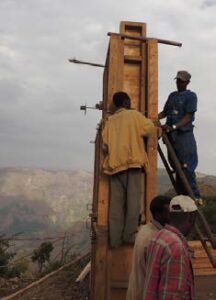Two talks were held recently at The Hive in Chisipite, Harare on the subject of building with earth. The discussions, which were free and open to the public, were held on 29th August and 5th September under the aegis of world renowned expert in Earth Building, Rowland Keable and organised by Gemma Temlett from Architextural Spatial Design. The talks were attended by architects, engineers, surveyors, designers, and other members of the construction industry as well as interested members of the public.
Keable is the CEO of EBUKI (Earth Building UK & Ireland), an organisation dedicated to promoting earth building in all its various forms. The organisation aims to disseminate information about earth building techniques as well as providing information and training for interested parties. Part of their mandate is to publish and set new standards to formalise the practice of earth building and to help this ancient technique become more acceptable to the mainstream. He is the author of various publications on the topic of earth construction, including (with Julian Keable) Rammed Earth Structures: A Code of Practice, which is considered the definitive resource on the subject.

Keable was instrumental in establishing the nationally recognised Code of Practice and Standards Document, approved by the Standards Association of Zimbabwe, and published as a National Standard in 2001. Based on this it was adopted by the African Regional Standard Organisation in 2016. By formalising the practice of Earth Building not only are high standards maintained but home owners are able to get mortgages on their properties, banks and finance houses can make loans available for prospective building projects, insurance values and property prices can be established, and so on.
Building with earth is one of the oldest construction methods and it’s been used on every continent in the world. It produces buildings that are extremely durable, easy to construct and maintain, eco-friendly and sustainable, as well as being quick and cheap to build. It’s a building method that’s been used for over 10,000 years and it’s estimated that today over a third of the world’s population lives in earth buildings. (See: https://www.designingbuildings.co.uk/wiki/Earth_building)
Perhaps one of the best known examples of earth buildings is the Great Mosque of Djenne in Mali, originally built in the 13th Century, and the earthen city of Timbuktu.
The Alhambra Palace in Spain is another example of extremely durable earth structures. Both the Great Mosque and the Alhambra have been declared Unesco World Heritage sites.
Although these were built in very dry climates relatively old earth buildings can still be found across Europe and even in equatorial and tropical regions where the rainfall is extremely high.
Building with earth takes many different forms and it takes various names in different parts of the world. It includes rammed earth construction, cob houses, wattle and daub – the local equivalent would be pole and dagga – hydroform bricks, unfired earth bricks and adobe. There are also straw bale houses with an earth based stucco as well as earth and lime plasters and decorative finishes.
The advantages of earth based buildings are that the materials used are highly sustainable and use far less resources to produce than fired clay bricks, concrete or steel. There is virtually no transport involved as materials are usually sourced on site so this cuts carbon emissions.
Earth structures provide excellent sound and thermal insulation reducing energy costs for heating and cooling. The materials used are non-toxic and non-polluting and known to improve indoor air quality through its hydroscopic qualities, regulating humidity and minimising the risk of mould growth and allergies. Construction can be done using a variety of specialised equipment and machinery like diggers and compressors, or it can simply be done by hand with very little training, experience or tools needed. SIRDC is currently offering a course in Rammed Earth Technology through their Building Technology Institute.

Because the process can be very labour intensive (if desired) it’s an ideal opportunity for employment creation. The process is quick and affordable enough to help solve Zimbabwe’s housing crisis. World-renowned local architect Mick Pearce is a great proponent of earth buildings and has constructed houses in Australia and Zimbabwe. One of his better known projects is the Earth House in Bonda, near Nyanga. On the international front award winning American architect Rick Joy is an influential supporter of earth building.
At Fusion we offer free site assessments and consultations for individual homeowners and developers so we can understand how best we can help you achieve a defined, refined and world-class finish regardless of your project size. We have unmatched experience in project management, installations and refurbishment of Hardwood Flooring, Decking, Cladding, Carpeting, Luxury Vinyl Tiling among a host of floor covering options. Our work speaks for itself!
text: Michael Nott
photos: courtesy of Rowland Keable and Gemma Temlett









